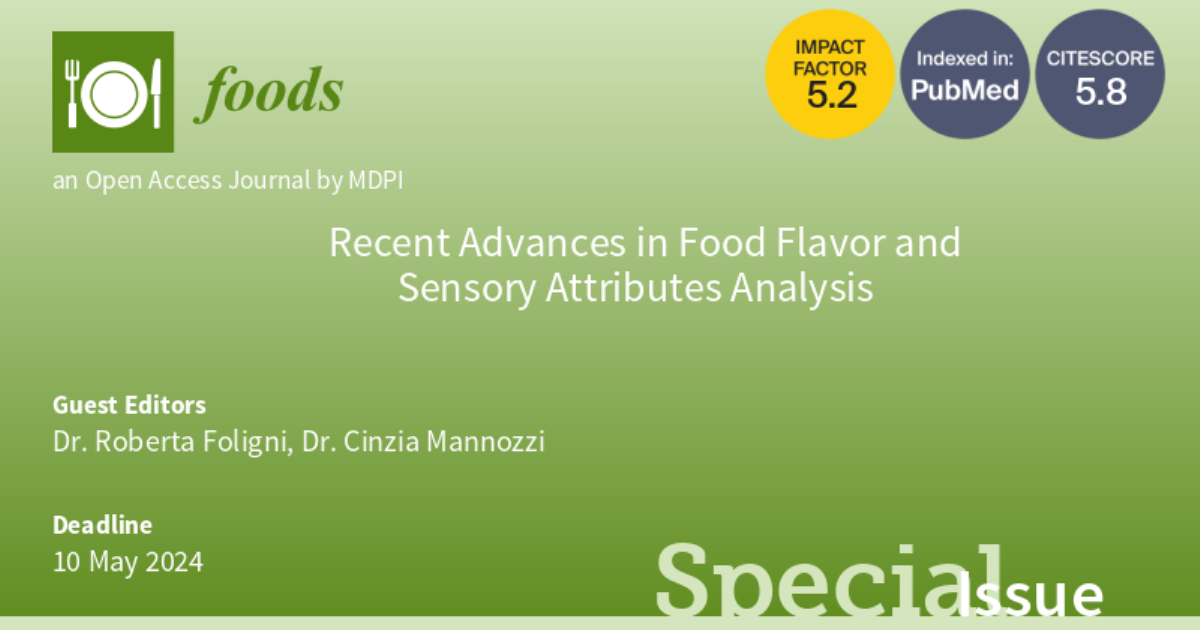Recent Advances in Food Flavor and Sensory Attributes Analysis
A special issue of Foods (ISSN 2304-8158). This special issue belongs to the section "Food Physics and (Bio)Chemistry".
Deadline for manuscript submissions: closed (10 May 2024) | Viewed by 12980

Special Issue Editors
Interests: food science and technology; food quality; food analysis; analytical food methods; food processing; gas/liquid-chromatography-mass spectrometry; aroma compounds; bioactive compounds; dairy products; food lipids; fatty acids; functional food; food waste; sustainability; novel foods; emerging technologies
Special Issues, Collections and Topics in MDPI journals
Interests: food quality; sustainability; functional food; novel foods; analytical food methods; gas/liquid chromatography–mass spectrometry; food processing; food technology; food chemistry; antioxidant activity; bioactive compounds; green extraction methods
Special Issues, Collections and Topics in MDPI journals
Special Issue Information
Dear Colleagues,
Flavor fingerprint plays a key role in determining the acceptability of foods and beverages by the consumer. This is currently of great interest in the scientific food sector. The evaluation, in terms of the quantification, chemical identification, and sensory properties of raw materials and finished products, is, in fact, often at the center of research projects in the food sector. Instrumental analysis coupled with sensory analysis, as well as characterizing the food, allows for evaluating the impact of different processing technologies and the use of a new ingredient, etc.
Results obtained from this kind of research are widely applied in many fields including quality control, food marketing, food inspection, and traceability. Scientific articles published in the field of flavor science and sensory evaluation have contributed greatly to the development and growth of food science and technology worldwide. This Special Issue is intended to collect high-quality manuscripts on research related to instrumental flavor analysis and sensory evaluation for the characterization of food matrices.
Dr. Roberta Foligni
Dr. Cinzia Mannozzi
Guest Editors
Manuscript Submission Information
Manuscripts should be submitted online at www.mdpi.com by registering and logging in to this website. Once you are registered, click here to go to the submission form. Manuscripts can be submitted until the deadline. All submissions that pass pre-check are peer-reviewed. Accepted papers will be published continuously in the journal (as soon as accepted) and will be listed together on the special issue website. Research articles, review articles as well as short communications are invited. For planned papers, a title and short abstract (about 250 words) can be sent to the Editorial Office for assessment.
Submitted manuscripts should not have been published previously, nor be under consideration for publication elsewhere (except conference proceedings papers). All manuscripts are thoroughly refereed through a single-blind peer-review process. A guide for authors and other relevant information for submission of manuscripts is available on the Instructions for Authors page. Foods is an international peer-reviewed open access semimonthly journal published by MDPI.
Please visit the Instructions for Authors page before submitting a manuscript. The Article Processing Charge (APC) for publication in this open access journal is 2900 CHF (Swiss Francs). Submitted papers should be well formatted and use good English. Authors may use MDPI's English editing service prior to publication or during author revisions.
Keywords
- food flavor
- volatile compounds
- sensory profile evaluation
- GC–MS analysis
- aroma chemical composition
- flavor chemistry
- traditional food
- novel food
- volatile fingerprint
- emerging technologies
Benefits of Publishing in a Special Issue
- Ease of navigation: Grouping papers by topic helps scholars navigate broad scope journals more efficiently.
- Greater discoverability: Special Issues support the reach and impact of scientific research. Articles in Special Issues are more discoverable and cited more frequently.
- Expansion of research network: Special Issues facilitate connections among authors, fostering scientific collaborations.
- External promotion: Articles in Special Issues are often promoted through the journal's social media, increasing their visibility.
- Reprint: MDPI Books provides the opportunity to republish successful Special Issues in book format, both online and in print.
Further information on MDPI's Special Issue policies can be found here.







